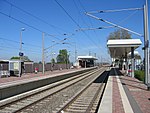Hambach surface mine

The Tagebau Hambach is a large open-pit coal mine (German: Tagebau) in Niederzier and Elsdorf, North Rhine–Westphalia, Germany. It is operated by RWE and used for mining lignite. The mine is on the site of the ancient Hambach Forest, which was purchased by RWE in 1978. The company then cut most of the forest down and cleared it to mine. Only 10% of the forest area remains. RWE planned to clear half of the remaining area between 2018 and 2020. This plan was met with massive protests in the autumn of 2018 and was temporarily stopped in October 2018 by the supreme administrative court of North Rhine–Westphalia (Oberverwaltungsgericht für das Land Nordrhein-Westfalen).Begun in 1978, the mine's operation area currently (as of end of 2017) has a size of 43.8 km2, with the total area designated for mining having a size of 85 km2. It is the deepest open pit mine with respect to sea level: the bottom of the pit, with up to 500 metres (1,640 ft) from the surface, is 299 metres (981 ft) below sea level, the deepest artificially made point in North Rhine–Westphalia.
Excerpt from the Wikipedia article Hambach surface mine (License: CC BY-SA 3.0, Authors, Images).Hambach surface mine
Geographical coordinates (GPS) Address Nearby Places Show on map
Geographical coordinates (GPS)
| Latitude | Longitude |
|---|---|
| N 50.910833333333 ° | E 6.5027777777778 ° |
Address
52382
North Rhine-Westphalia, Germany
Open on Google Maps









